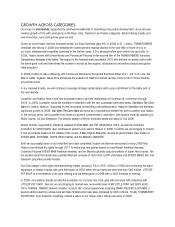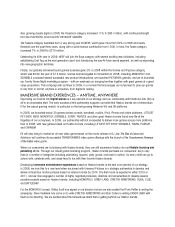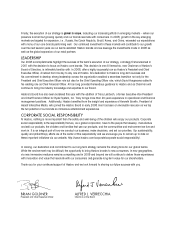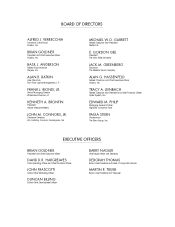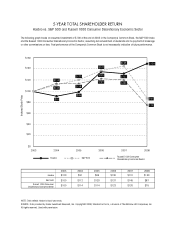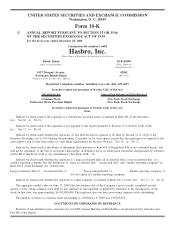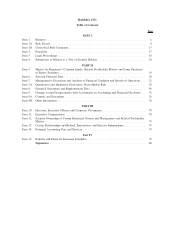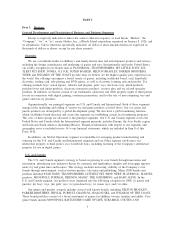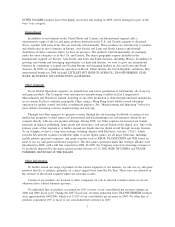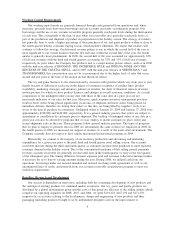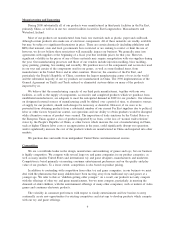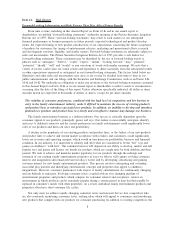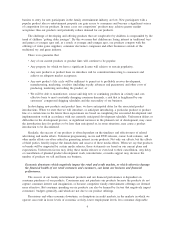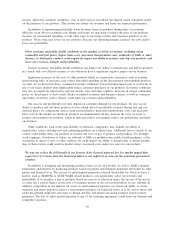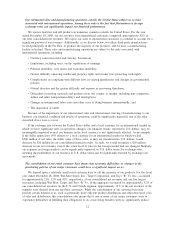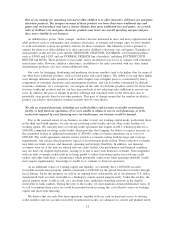Hasbro 2008 Annual Report Download - page 14
Download and view the complete annual report
Please find page 14 of the 2008 Hasbro annual report below. You can navigate through the pages in the report by either clicking on the pages listed below, or by using the keyword search tool below to find specific information within the annual report.
Working Capital Requirements
Our working capital needs are primarily financed through cash generated from operations and, when
necessary, proceeds from short-term borrowings and our accounts receivable securitization program. Our
borrowings and the use of our accounts receivable program generally reach peak levels during the third quarter
of each year. This corresponds to the time of year when our receivables also generally reach peak levels as
part of the production and shipment of product in preparation for the holiday season. The strategy of retailers
has generally been to make a higher percentage of their purchases of toy and game products within or close to
the fourth quarter holiday consumer buying season, which includes Christmas. We expect that retailers will
continue to follow this strategy. Our historical revenue pattern is one in which the second half of the year is
more significant to our overall business than the first half and, within the second half of the year, the fourth
quarter is generally more predominant. In 2008, the second half of the year accounted for approximately 63%
of full year revenues with the third and fourth quarters accounting for 32% and 31% of full year revenues,
respectively. In years where the Company has products tied to a major motion picture release, such as in 2008
with the mid-year releases of IRONMAN, THE INCREDIBLE HULK and INDIANA JONES AND THE
KINGDOM OF THE CRYSTAL SKULL, and in 2007 with the mid-year releases of SPIDER-MAN 3 and
TRANSFORMERS, this concentration may not be as pronounced due to the higher level of sales that occur
around and just prior to the time of the motion picture theatrical release.
The toy and game business is also characterized by customer order patterns which vary from year to year
largely because of differences each year in the degree of consumer acceptance of product lines, product
availability, marketing strategies and inventory policies of retailers, the dates of theatrical releases of major
motion pictures for which we have product licenses, and changes in overall economic conditions. As a result,
comparisons of our unshipped orders on any date with those at the same date in a prior year are not
necessarily indicative of our sales for that year. Moreover, quick response inventory management practices
result in fewer orders being placed significantly in advance of shipment and more orders being placed for
immediate delivery. Retailers are timing their orders so that they are being filled by suppliers, such as us,
closer to the time of purchase by consumers. Unshipped orders at January 25, 2009 and January 27, 2008 were
approximately $108,000 and $149,000, respectively. It is a general industry practice that orders are subject to
amendment or cancellation by customers prior to shipment. The backlog of unshipped orders at any date in a
given year can also be affected by programs that we may employ to incent customers to place orders and
accept shipments early in the year. These programs follow general industry practices. The types of programs
that we plan to employ to promote sales in 2009 are substantially the same as those we employed in 2008. In
the fourth quarter of 2008 we increased our support of retailers as a result of the weak retail environment. The
Company currently does not expect to have similar incremental promotional programs in 2009.
Historically, we commit to the majority of our inventory production and advertising and marketing
expenditures for a given year prior to the peak third and fourth quarter retail selling season. Our accounts
receivable increase during the third and fourth quarter as customers increase their purchases to meet expected
consumer demand in the holiday season. Due to the concentrated timeframe of this selling period, payments
for these accounts receivable are generally not due until later in the fourth quarter or early in the first quarter
of the subsequent year. The timing difference between expenses paid and revenues collected sometimes makes
it necessary for us to borrow varying amounts during the year. During 2008, we utilized cash from our
operations, borrowings under our secured amended and restated revolving credit agreements as well as our
uncommitted lines of credit, and proceeds from our accounts receivable securitization program to meet our
cash flow requirements.
Royalties, Research and Development
Our success is dependent on innovation, including both the continuing development of new products and
the redesign of existing products for continued market acceptance. Our toy, game and puzzle products are
developed by a global development group and the costs of this group are allocated to the selling entities which
comprise our operating segments. In 2008, 2007, and 2006, we spent $191,424, $167,194 and $171,358,
respectively, on activities relating to the development, design and engineering of new products and their
packaging (including products brought to us by independent designers) and on the improvement or
4


